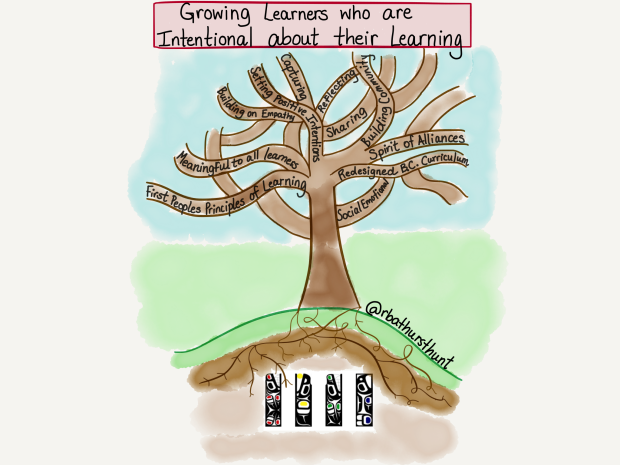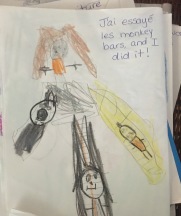
Aboriginal Artwork in Sketchnote -The Spirit of Alliances
Here is an overview of my share yesterday at the GAFE Summit. Click here for my slides.
I began this school year with reviewing and connecting with my driving question as an educator: how can I support learners in truly learning how to learn? Before I begin a new term, year, learning activity, inquiry project, etc. I always try to look back to my driving question. I always look back, because I need to ensure whatever we are doing is going to be supporting this driving question. I always also like to reconnect with my core as an educator, to ensure our new learning adventure is connected to the things I value most
.
 I created this sketch that represents my core and heart as an educator. These sketches share what is most important for me in guiding my learners through and inviting them to experience together.
I created this sketch that represents my core and heart as an educator. These sketches share what is most important for me in guiding my learners through and inviting them to experience together.
Love of learning: Developing this through play-based, hands-on, and imaginative learning.
Connected learning: connected to our land, connected to our past and present.
Visible learning: Making learning visible and sharing.
Seamless Integration of Tech: No longer a stand alone, always woven in when appropriate and powerful.
Celebration: Ongoing celebration and reflection of where we are, where we came from and where we are going.
Relationships: Building strong partnerships with all. Learners, families, colleagues, community and more.
Learner Interest: Following the lead of my learners.
Inquiry-based learning: Inviting and celebrating questions, following ideas and developing independent learning skills that are driven from learners’ passions. 
Back in September, after reviewing all these important components, I decided I needed to focus on an essential question to benefit the learners in our group: HOW CAN I SUPPORT LEARNERS IN SETTING POSITIVE LEARNING INTENTIONS? I decided that this was a great start, but I needed to ground our learning intentions in something powerful and connected. I then came across the Spirit of Alliances, and they fit tremendously. Now I had something: teaching learners how to be intentional about their learning through the history and teachings of our land.  Here is the First Principles of
Here is the First Principles of
Learning, that is also an ongoing resource I am checking in with and evaluating how I can infuse more of the First Peoples’ Principles of Learning principles into our learning.
Well, I was ready to start… but then I wasn’t sure where to start. So I decided to begin with a literacy introduction, using a story created in our district to introduce the Spirit of Alliances. I also created a provocation as an invitation to play with the animals. I believe that children need to have the opportunity to play and explore, in order to create their own connections and understanding to something. This provocation table did just this. Children were interacting, creating stories and adventures and creating an attachment to the animals. This was exciting and powerful to witness.
We then decided it was time to unpack each Spirit of Alliance animals, and create our own meaning. I kept thinking back to my driving and essential questions, to ensure I was on track and still working towards meeting my goal and doing I believe is best for my learners.
 We unpacked each animal. We had learned about each animal’s teaching and meaning through our literacy introduction, the Four Stones book, and now we had the chance to come up our own individual examples of times in our lives we were like each animal. For more on this, please check out my post on Growth Mindset and learning about the Salmon. We did a similar lesson for each animal and then accompanied it with a journal entry.
We unpacked each animal. We had learned about each animal’s teaching and meaning through our literacy introduction, the Four Stones book, and now we had the chance to come up our own individual examples of times in our lives we were like each animal. For more on this, please check out my post on Growth Mindset and learning about the Salmon. We did a similar lesson for each animal and then accompanied it with a journal entry.
Once we had a strong understanding and our own, five year old fr iendly, descriptions for each animal’s teachings we embarked on creating our class agreement and everyone signed it. The agreement signifies that, throughout our Kindergarten year, we will all be working our best towards being like the four Spirit of Alliance animals.
iendly, descriptions for each animal’s teachings we embarked on creating our class agreement and everyone signed it. The agreement signifies that, throughout our Kindergarten year, we will all be working our best towards being like the four Spirit of Alliance animals.
Underneath here, in the photograph, you can see an example of a child bringing in a piece of art she had created at home to represent the colours associated with each animal. This, to me, is a clear example of how much my learners feel connected to what we are doing, to our land, and how the Spirit of Alliances has a strong place in their heart.
Next we began setting positive learning intentions based on the traits of each animal. This process was scaffolded, with lots of modeling and sharing of intentions. Some examples of Kindergarten intentions might be:
Bear – Keeping my hands to myself and my body calm.
Raven -Sharing my special gift of being able to puzzles with a friend.
Wolf -Being kind to a friend during exploration play time.
Salmon -Not giving up on the monkey bars during recess.
Each morning we have mindfulness and reflection time, which begins with Yoga poses and mindfulness reflections, for more on this please see my post. I then walk the learners through reflecting on their yesterday’s intentions and then shifting gears and setting new learning intentions for today. We then join at the carpet and whilst the children are sharing their intentions, I move their names as a visual and a commitment for the day. This is board is a great visual and tool to refer back to during the day, to ensure our actions are being taken with our animal’s lens and focus.
So, we were setting positive learning intentions, rooted in the Spirit of alliances, each day. I then looked back at my initial questions. I needed to extend what we are doing. I had a few questions and hunches of where we could go next.
I wanted to ensure what I was doing was connected to the redesigned BC Curriculum. AND, it is in every strand and subject area. This was powerful to realize and not that I needed a confirmation that what I was doing was important, but it was nice to see how it connected in numerous ways.
I needed to think about how I was going to add what we are doing to my assessment, evaluation and report cards. I use Fresh Grade as an ongoing portfolio and assessment piece to include families in our dialogue. So to demonstrate and share learning snapshots and assessments was easy and working. I then was fortunate to be shown an incredible blog to support Term Overviews using the redesigned Curriculum. I took the fabulous layout, ideas and incorporation of the Core Competences, not curricular, and remixed and created one to fit our learning. Please visit Reno by Class.
Here is a link to my overview and reflection page for this term:
I then looked at how might I extend what we are doing with our intentions. I needed to ensure that I was providing room for reflections, growth and making our learning visible. Here are some of the ways we are doing this.
Nametags to keep us on track, to spark conversation and as another visual to track our goals. These have been working fabulously!

Journals and Circle Reflections have been keeping our conversations going about our intentions and goals. We enjoy journaling and sharing in a circle about how we are working towards meeting our intentions, and making adjustments when necessary.
 iPads for documentation, celebrating and making our learning visible. PicCollage is a great tool to help us take photos of ourselves reaching our goals and then sharing and reflecting on them with our group. This is wonderful to witness!
iPads for documentation, celebrating and making our learning visible. PicCollage is a great tool to help us take photos of ourselves reaching our goals and then sharing and reflecting on them with our group. This is wonderful to witness!

GOPROS! This will be a full post for another time. But for now I will leave with these two short clips. Learners have an ongoing invitation to use the GoPro to capture themselves meeting their goal, and then we use them to share a bit of the footage to reflect.
Being like Raven to share her special gift of rainy day puddle jumping adventures:
Being like Salmon in not giving up, and sitting for 40 minutes using a stencil she had been trying to use ALL week. She was so proud, in a very humble way, of her work. You will want to mute your sound for hers, because I sped up the video.
So much more to come on this as our adventure, with learning intentions based on the history of our land, is just beginning. Please stay tuned. In the mean time, I challenge you to be like Salmon and try something new in your teaching. Begin with a driving question and just start!
Artwork below from The Spirit of Alliances

Thank you,
Rebecca








You are doing some brilliant things in your classroom, Rebecca! It would be great if we could arrange to have you visit SD73 to present to our teachers about this project. So inspiring and wonderful! Thank you for sharing!!!
LikeLike
Thank you so much for your feedback, Tracy. That sounds like an amazing opportunity. Thanks for thinking of me.
LikeLike
Glad you will be in SD73 in April to share the great things you’ve been doing! So excited to see you here!
I love the kid language for the animal’s teachings / attributes that you created for the bear and the salmon. Would you be willing to share what you came up with for the raven and wolf?
LikeLike
Rebecca,
This is exactly what I was looking for! I have been following your blog for a while and have been inspired to use these teachings with my kids. Thank you for sharing!
LikeLike
Thanks, Nikki! I love your enthusiasm. I would just look into your district’s aboringial enhancement agreement. And check for permission in teaching these specific traits and teachings, to ensure they align with your district’s. I would love to hear how it goes. Thanks!
LikeLike
Hello Rebecca,
My name is Margie Radigan and I teach Nature Kindergarten here in Nanaimo at the Departure Bay Elementary Eco School. Earlier in July my good friend, Tanya Lebans, shared your Blog link with me while you were attending VIU. I am curious about how I may be able to purchase a copy of the resource, The Four Stones?
I would also be interested in chatting with you more about your program.
Take care,
Margie Radigan
LikeLike
Thanks for your comment, Margie. Send me an email. I’d love to connect and chat. Thanks! rbathurst@sd61.bc.ca
LikeLike